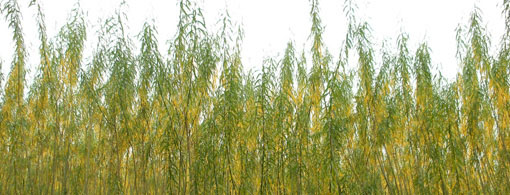Analysis of Coppices

Background
These energy crops, often referred to as short rotation coppices (SRCs), include the hardwoods willow, poplar, and robina, and are currently the most abundantly used energy crop feedstock worldwide for biomass fuelled electricity and energy generation. It is well established as an energy crop due to its relatively high yields, ability to grow in various climates, and the relatively low maintenance costs/times required once the crop is established.Coppice plantations are currently established from 20-25 cm long un-rooted stem cuttings vertically planted in a seed-bed. Immediately after planting, a pre-emergent herbicide is usually applied to prevent germination of annual weeds. By the end of the first growing season, usually in November, the trees will have reached a height of approximately one to two and a half metres and usually have one to four stems.
Coppicing the stems at a height of 2-5 cm promotes multiple sprout formation, which results in rapid canopy closure in the second growing season.
After the second growing season little maintenance is required, apart from disease/insect monitoring. The number of years between harvests is defined as the cutting cycle. SRCs generally have cutting cycles of between two and five years. Conventionally, it has been recommended that harvesting should occur in the winter, when the plants are dormant and their leaves have fallen, and be completed by bud swell. This period would usually be approximately four months - between late November and mid March. Due to the heavy nature of the harvesting machinery, operations are not considered possible when the soil is wet. Some studies indicate that year-long harvesting is possible, although there are yield losses associated with summer harvesting. These losses need to be weighed against dry matter losses experienced in storage.
The harvesters used tend to either cut and chip the coppice in one operation, or harvest the whole stems for later comminution.
Analysis of Coppices at Celignis
Celignis Analytical can determine the following properties of Coppices samples:
Sugars (Monosaccharides)
Sugar Alcohols and Uronic Acids
Lignin and Extractives
- Lignin (Klason)
- Lignin (Klason - Protein Corrected)
- Lignin (Acid Soluble)
- Acid Insoluble Residue
- Extractives (Ethanol-Soluble)
- Extractives (Water-Soluble)
- Extractives (Exhaustive - Water then Ethanol)
- Lignin S/G Ratio
- Extractives (Water-Insoluble, Ethanol Soluble)
- Protein Content of Acid Insoluble Residue
- Carbon Content of Acid Insoluble Residue
- Hydrogen Content of Acid Insoluble Residue
- Nitrogen Content of Acid Insoluble Residue
- Sulphur Content of Acid Insoluble Residue
Amino
Acids
Thermal Properties
- Moisture
- Ash
- Ash (Acid Insoluble)
- Carbon
- Hydrogen
- Nitrogen
- Sulphur
- Oxygen
- Volatile Matter
- Fixed Carbon
- Gross Calorific Value
- Net Calorific Value
- Chlorine
- Ash Shrinkage Starting Temperature (Oxidising)
- Ash Deformation Temperature (Oxidising)
- Ash Hemisphere Temperature (Oxidising)
- Ash Flow Temperature (Oxidising)
- Ash Shrinkage Starting Temperature (Reducing)
- Ash Deformation Temperature (Reducing)
- Ash Hemisphere Temperature (Reducing)
- Ash Flow Temperature (Reducing)
- Thernogram - Under Nitrogen
- Thermogram - Under Air
Major and Minor Elements
Cellulose Content of Coppices
Coppices are hardwoods and have a good cellulose content. The whole-plant cellulose content will depend on: the productivity of the tree; the mass ratio of stem biomass to foliage; the cutting cycle; and the particular coppice variety.Click here to see the Celignis Analysis Packages that determine cellulose content.
Hemicellulose Content of Coppices
Coppices are hardwoods and will typically have a lower hemicellulose content than herbaceous energy crops (e.g. Miscanthus). The principal hemicellulose sugar is xylose with small amounts of galactose, mannose,arabinose, and rhamnose present.Click here to see the Celignis Analysis Packages that determine hemicellulose content.
Lignin Content of Coppices
As hardwoods coppices will have a good lignin content. The whole-plant lignin content will depend on: the productivity of the tree; the mass ratio of stem biomass to foliage; the cutting cycle; and the particular coppice variety.Click here to see the Celignis Analysis Packages that determine lignin content.
Starch Content of Coppices
The starch content of coppices varies between the different anatomical components of the plant. Typically it is highest in the leaves, where photosynthesis takes place, and lower in the stems. The starch content can also vary according to the maturity of the plant.Click here to see the Celignis Analysis Packages that determine starch content.
Uronic Acid Content of Coppices
The uronic acids glucuronic acid and galacturonic acid are present in the hemicelluloses of coppices.Click here to read more about uronic acids and to see the Celignis Analysis Packages that determine uronic acid content.
Enzymatic Hydrolysis of Coppices
We can undertake tests involving the enzymatic hydrolysis of Coppices. In these experiments we can either use a commercial enzyme mix or you can supply your own enzymes.We also offer analysis packages that compare the enzymatic hydrolysis of a pre-treated sample with that of the native original material.
Click here to read more about enzymatic hydrolysis and to see the various analysis packages that we offer.
Ash Content of Coppices
The ash content of coppices is typically reasonably low although this will be dependent on the variety and the amount of foliage present on the standing crop.Click here to see the Celignis Analysis Packages that determine ash content.
Heating (Calorific) Value of Coppices
Coppices have good heating values, meaning that they are suitable for utilisation in boilers for the production of heat and/or electricity. However the effective heating value will depend greatly on the moisture content of the crop.Click here to see the Celignis Analysis Packages that determine heating value.
Bulk Density of Coppices
At Celignis we can determine the bulk density of biomass samples, including Coppices, according to ISO standard 17828 (2015). This method requires the biomass to be in an appropriate form (chips or powder) for density determination.Click here to see the Celignis Analysis Packages that determine bulk density.
Basic Density of Coppices
At Celignis we can determine the basic density of some suitable biomass samples. The method requires the biomass to be in an appropriate form (chips) for density determination.Click here to see the Celignis Analysis Packages that determine basic density.
| Previous Feedstock | Next Feedstock |
Go Back to List of Feedstocks.
Energy
Crops
Agricultural Residues and Wastes
Industrial Residues and Wastes
Municipal
Wastes
Biorefinery
Products






